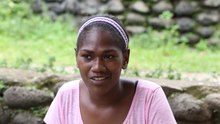부러스어
Vurës language| 부러스 | |
|---|---|
| 부레아스 | |
| 발음 | [βyrœs] |
| 네이티브: | 바누아투 |
| 지역 | 바누아 용암 |
원어민 | 2,000 (2012)[1] |
| 언어 코드 | |
| ISO 639-3 | msn(Mwesen과 공유) |
| 글로톨로지 | vure1239 |
| ELP | 부러스 |
부레스(Vureas, Vures)는 바누아 용암섬의 남쪽에 있는 바누아 용암섬에서 약 2000명의 화자가 사용하는 오세아니아어다.[2]
부레스는 언어학자 Catriona Malau에 의해 문법과[2] 사전의 형태로 묘사되었다.[3]
이름
부러스[βyrœs]라는 이름은 바누아 용암 남서쪽에 위치한 만을 언어 자체로 따서 명명되었다.모타에서 만은 부레아[βureas]라고 한다.이들은 *βureas(i,u) 형태의 재구성된 프로토토토레스 뱅크에서 유래한다.
변증법
부레스는 이웃 언어인 Mwesen과 충분한 유사성을 보여주는데, 그 둘은 때때로 Mosina(모타어로 Mwesen 마을의 이름 뒤에)라고 불리는 단일 언어의 방언으로 여겨져 왔다.그리고 실제로 2018년 한 글로트메트릭 연구는 부러스와 Mwesen이 역사적 혁신의 85%를 공유한다는 것을 계산하여, 이 두 강의들 사이에 공유된 발전의 오랜 역사를 밝혀냈다.[4]
그러나 연구 결과에 따르면 Mwesen과 Vureres는 모음 시스템,[5] 명사 기사,[6] 대명사 패러다임[7][8] 등 다양한 차이점을 가지고 있으며 이는 명확하게 구별되는 것으로 간주될 수 있을 만큼 충분히 다르다.
음운론
자음
| 라비알- 벨라르 | 라비알 | 치과의 | 치조류 | 벨라르 | 글로탈 | ||
|---|---|---|---|---|---|---|---|
| 플로시브 | 무성음의 | K͡pʷ ⟨q⟩ | t̪ ⟨⟩ | k ⟨k⟩ | (ʔ) | ||
| 혼전의 | ᵐb ⟨b | ⁿd ⟨d | |||||
| 콧물 | ŋ͡mʷ ⟨m̄⟩ | m ⟨m⟩ | n ⟨n⟩ | ŋ nn̄⟩ | |||
| 프리커티브 | β ⟨v⟩ | S ⟨s⟩ | ɣgg⟩ | ||||
| 액체 | 독성이 있는 | r ⟩⟩ | |||||
| 측면의 | l ⟨⟩ | ||||||
| 세미보울 | w ⟨w⟩ | ||||||
- /r/는 탭[ []으로 자유 변형으로도 들린다.
- glottal stop /poss/ 어떤 단어에서는 드물게 발생한다.
- /β/는 무성 정지 전에 [p̚]로 들린다.
- /k͡pʷ/는 다른 자음 앞에 있을 때 [k͡p]로 들린다.
- 정지음 /t̪ k/는 모음 전에 [t̪ʰ kʰ] 흡인된다.[9]
모음.
부러스에는 9개의 음소모음이 있다.모두 짧은 단음절 /i e ɛ a ø ø y o o/:[10][11]
| 앞면 | 뒤로 | ||
|---|---|---|---|
| 평이한 | 둥글게 | ||
| 가까운. | i⟩ | y y⟩ | (ʊ) ⟨u |
| 클로즈미드 | e ⟨⟩⟩ | ø ⟨ö⟩ | 오오오오오오오오오오오오오오 |
| 오픈미드 | ɛe⟩ | œ ⟨ë⟩ | ɔ o⟩ |
| 개방하다 | ⟨a⟩. | ||
참조
인용구
- ^ 프랑수아 2012, 페이지 88.
- ^ a b 말라우 2016.
- ^ 말라우로2021번길
- ^ 칼리안 & 프랑수아 2018.
- ^ 프랑수아 2005년
- ^ 프랑수아 2007년
- ^ 프랑수아 2009년
- ^ 프랑수아 2016.
- ^ a b 말라우 2016, 페이지 20.
- ^ 프랑수아 2005년 페이지 446.
- ^ 프랑수아 2011년 페이지 194.
- ^ 프랑수아 2005, 페이지 459-460.
참고 문헌 목록
- Malau, Catriona (2016). A Grammar of Vurës, Vanuatu. Pacific Linguistics, 651. Berlin/Boston: De Gruyter Mouton. ISBN 978-1-5015-0364-1.
- Malau, Catriona (2021). A Dictionary of Vurës, Vanuatu. Asia-Pacific Linguistics (1st ed.). Canberra: ANU Press. ISBN 978-1-76046-460-8. Retrieved 2021-07-10.
- François, Alexandre (2005), "Unraveling the history of the vowels of seventeen northern Vanuatu languages", Oceanic Linguistics, 44 (2): 443–504, doi:10.1353/ol.2005.0034, S2CID 131668754
- François, Alexandre (2007), "Noun articles in Torres and Banks languages: Conservation and innovation", in Siegel, Jeff; Lynch, John; Eades, Diana (eds.), Language Description, History and Development: Linguistic indulgence in memory of Terry Crowley, Creole Language Library 30, Amsterdam: Benjamins, pp. 313–326, doi:10.1075/cll.30.30fra
- François, Alexandre (2009), "Verbal aspect and personal pronouns: The history of aorist markers in north Vanuatu", in Pawley, Andrew; Adelaar, Alexander (eds.), Austronesian historical linguistics and culture history: A festschrift for Bob Blust, vol. 601, Canberra: Pacific Linguistics, pp. 179–195
- François, Alexandre (2011), "Social ecology and language history in the northern Vanuatu linkage: A tale of divergence and convergence", Journal of Historical Linguistics, 1 (2): 175–246, doi:10.1075/jhl.1.2.03fra, hdl:1885/29283.
- François, Alexandre (2012), "The dynamics of linguistic diversity: Egalitarian multilingualism and power imbalance among northern Vanuatu languages", International Journal of the Sociology of Language, 2012 (214): 85–110, doi:10.1515/ijsl-2012-0022, S2CID 145208588
- François, Alexandre (2016), "The historical morphology of personal pronouns in northern Vanuatu", in Pozdniakov, Konstantin (ed.), Comparatisme et reconstruction : tendances actuelles, Faits de Langues, vol. 47, Bern: Peter Lang, pp. 25–60
- Kalyan, 시바, 프랑수아, 알렉상드르(2018년),"역사 Glottometry을 위해 나무를 모델에서 비교 법 해:프레임워크"(PDF), Kikusawa, 리쓰코에, 리드, 로리(eds.), 나무 이야기를 해 보자:.언어, Senri 민속 연구, 98, Ōsaka:국립 민족학 박물관,를 대신하여 서명함. 59–89 중 Representing Phylogenic의 관계에 문제점을 다루는 것.
외부 링크
| 카테고리 조회:무료 사전인 위키트리노에 나오는 부러스 레마. |
- 부러스—Catriona Malau의 영어 사전.
- A에 의해 공개 액세스, Vureres 언어로 녹음된 오디오.프랑수아(Pangloss Collection, CNRS).



